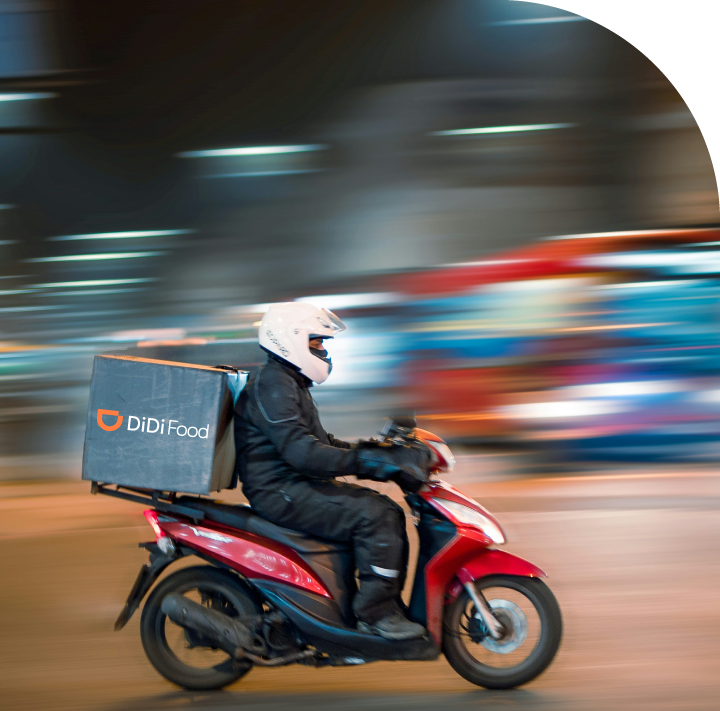Introduction
In the competitive food delivery market, access to real-time and organized restaurant menu data is essential for companies, researchers, and data analysts. The need to Extract DiDi Food App Menu Data is now a practice that cannot be avoided as DiDi Food, a subsidiary of Chinese ride-hailing giant DiDi Chuxing, broadens its operations in Latin American countries such as Mexico, Brazil, and Colombia. As the platform becomes increasingly influential in these markets, Web Scraping DiDi Food Delivery Data can provide valuable insights into restaurant offerings, pricing strategies, local food preferences, and customer behavior.
Menu data from DiDi Food includes restaurant names, food items, item descriptions, prices, category labels (e.g., combo, drinks, sweets), and add-on information. Competitive intelligence, culinary trends, and operational strategies in food tech and hospitality sectors can be derived by stakeholders using DiDi Food Restaurant Data Scraping with the aid of this structured data by scraping it.
This document prescribes how to Extract DiDi Food App Menu Data, offers an analytical study based on samples obtained across different locations, and delves into the future implications of Web Scraping DiDi Food Food Delivery Data in market research, menu engineering, and digital strategy.
Methodology
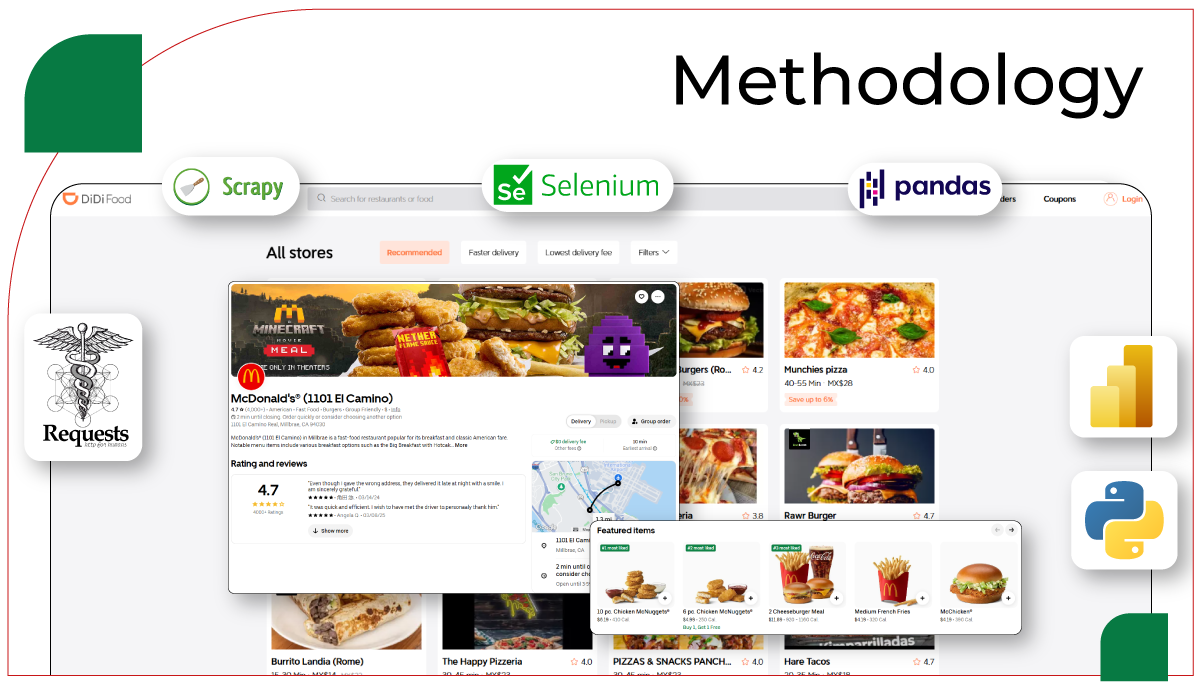
Extracting menu data from the DiDi Food app requires a systematic and well-defined scraping approach. Traditional methods are often insufficient since much of the data is dynamically loaded. Using a DiDi Food App Data Scraper, researchers and analysts can simulate app behavior or access publicly available endpoints to gather relevant information. This involves emulating user interactions within the app to capture real-time menu listings, restaurant names, pricing, descriptions, add-ons, and food categories. Proxy servers and user-agent rotation are employed to avoid detection and ensure access across different regions. The goal is to Extract Order and Menu Data from DiDi Food in a structured format, enabling comparative analysis between restaurants and regions. This technique benefits Extract DiDi Food Delivery Insights, including average pricing, delivery estimates, and customer preferences. With the right tools and methods, businesses can gain a competitive edge by analyzing and leveraging this data for operational decisions.
Tools Used
- Programming Language: Python
- Libraries: Selenium, BeautifulSoup, Requests, Pandas
- User Agent Rotator: To avoid request blocking
- Proxies: Residential proxies to mimic local IPs
- Target Platform: DiDi Food Mobile App (Android emulator) and Web Version (where available)
Data Points Collected
The following data points were extracted:
- Restaurant Name
- Restaurant Category (e.g., fast food, bakery)
- Cuisine Type (e.g., Mexican, Italian)
- Food Item Name
- Price (in local currency)
- Description
- Add-ons or Modifiers (e.g., extra cheese, drinks)
- Estimated Delivery Time
- Rating (where available)
Locations Covered
To generate a representative dataset, menu data was extracted from three major cities:
- Mexico City, Mexico
- São Paulo, Brazil
- Bogotá, Colombia
Ethical and Legal Considerations
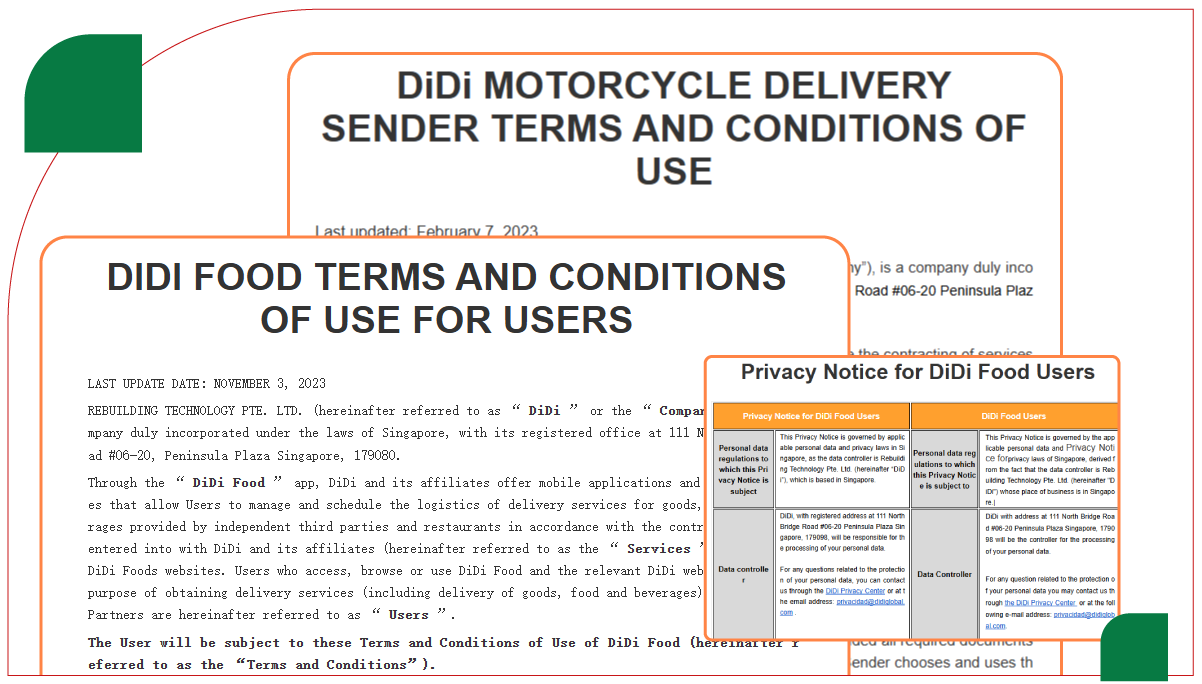
Scraping DiDi Food Restaurant and Menu Data was conducted strongly emphasizing ethical data collection practices. All scraping activities were confined strictly to publicly accessible information, ensuring no breach of private or restricted content. Automated crawlers were carefully configured to respect the platform’s robots.txt directives and operate within usage thresholds to avoid overloading the servers. The objective of this initiative was solely academic and analytical, with all collected data utilized strictly for research and non-commercial purposes. By following these guidelines, the DiDi Food platform's integrity was preserved while enabling meaningful insights. The methodology aligns with best practices for DiDi Food Food Delivery App Data Scraping Services , ensuring transparency and compliance. DiDi Food Delivery Scraping API Services can provide reliable access to structured data streams, supporting market research, trend analysis, and digital innovation in the online food delivery sector for organizations looking to automate data collection responsibly.
Detailed Analysis
Through Restaurant Menu Data Scraping , we collected detailed information from over 450 restaurants and more than 4,800 unique menu items on the DiDi Food app. This comprehensive dataset enabled us to conduct a focused analysis, segmenting the results by region and cuisine type to uncover patterns in pricing, item availability, and food preferences. Utilizing Restaurant Data Intelligence Services , we identified key trends such as the dominance of fast food in urban areas and a higher diversity of traditional cuisine in suburban zones. These insights are valuable for stakeholders aiming to optimize their offerings or enter new markets. The structured data provides a clear snapshot of menu strategies and regional demand across DiDi Food’s active markets.
Average Pricing by Region
| City |
Average Price per Item (Local Currency) |
Popular Cuisine |
| Mexico City |
MXN 92.5 |
Tacos, Burgers |
| São Paulo |
BRL 21.3 |
Pizza, Acai Bowls |
| Bogotá |
COP 14,700 |
Arepas, Chicken |
The pricing differences reflect not only currency value but also regional purchasing power and vendor pricing strategies. For instance, combo meals in Mexico City tend to be priced higher due to inclusion of drinks and fries, whereas in Bogotá, traditional meals like arepas are offered at more affordable rates.
Item Category Distribution
As part of our Food Delivery Data Scraping Services , we organized each extracted menu item into primary categories, including Mains, Drinks, Desserts, and Add-ons. This classification helped streamline the analysis and allowed us to identify the distribution and popularity of each category across different regions. Leveraging Food Delivery Scraping API Services , we ensured accurate tagging and consistent data formatting to enable deeper insights into restaurant offerings. The following table presents the segmented breakdown, highlighting which menu types dominate in the DiDi Food app and how customer preferences vary by location and restaurant category.
| Category |
Mexico City (%) |
São Paulo (%) |
Bogotá (%) |
| Mains |
64.2% |
58.9% |
62.1% |
| Drinks |
15.1% |
19.7% |
17.5% |
| Desserts |
9.4% |
11.2% |
8.7% |
| Add-ons |
11.3% |
10.2% |
11.7% |
Mains consistently dominate the menu across all cities, with Brazil (São Paulo) showing a higher proportion of drinks and desserts, likely reflecting the tropical climate and cultural preferences for sweet beverages and acai-based products.
Key Insights and Trends

- Combo Meals and Add-Ons: Combo meals were found in over 60% of fast-food restaurant listings. Typical combos include a main item (burger or wrap), a side (fries), and a drink. Interestingly, more than 35% of these meals allowed optional customization with add-ons like extra meat, cheese, or sauces. This modular pricing structure shows how restaurants on DiDi Food are adapting to customer preferences and increasing order value through customization.
- Vegetarian and Vegan Options: Only about 14% of restaurants offered clearly labeled vegetarian or vegan dishes. These were more common in São Paulo, where health-conscious dining trends are growing. However, Bogotá had minimal vegetarian options, suggesting room for market development.
- Item Descriptions and Visual Appeal: Roughly 82% of listings contained short descriptions (under 100 characters), often emphasizing freshness, portion size, or signature ingredients. However, the presence of high-quality food images was inconsistent. Mexico City had the most visually enriched listings, while Bogotá's menus were often text-only.
- Delivery Time Estimates: Estimated delivery times ranged between 25 and 50 minutes. Restaurants with quicker delivery estimates received better ratings (averaging 4.6 stars) compared to those with longer wait times (averaging 4.1 stars), highlighting the importance of timely service in user satisfaction.
Use Cases of Extracted DiDi Food Menu Data
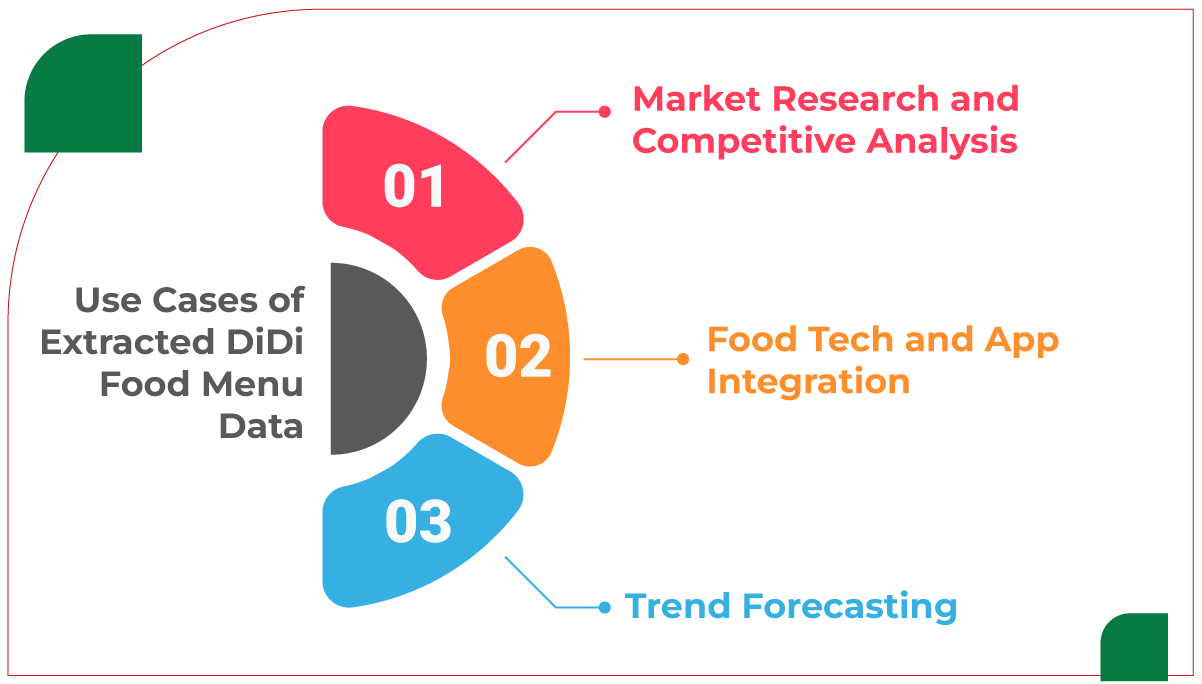
- Market Research and Competitive Analysis: Businesses can benchmark menu pricing, item availability, and cuisine popularity across cities to make strategic decisions. For example, a new fast-casual brand entering Mexico City can analyze popular item combos and adjust their offerings accordingly.
- Food Tech and App Integration: Developers and aggregators can use the menu data to build comparative price tools, dietary filters, or AI-based meal recommendation engines.
- Trend Forecasting: Identifying popular or emerging food categories (e.g., acai bowls in Brazil or artisanal tacos in Mexico) helps delivery platforms and cloud kitchens align their offerings with consumer demand.
Challenges and Limitations
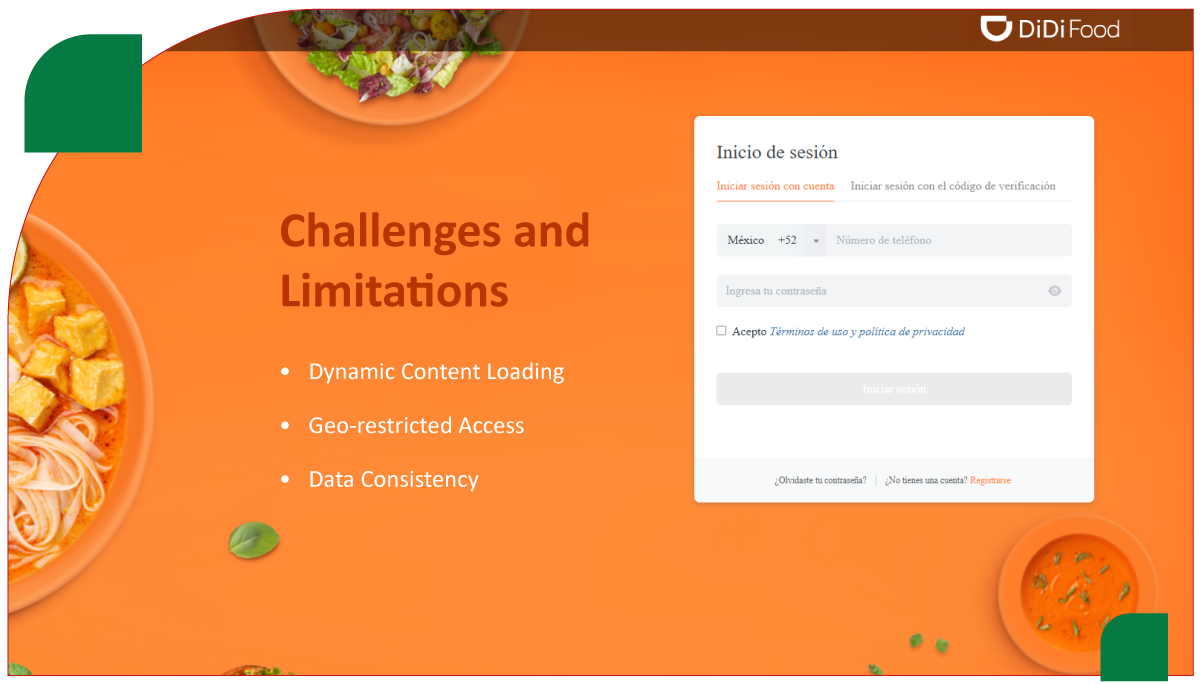
- Dynamic Content Loading: DiDi Food app uses dynamic JavaScript rendering for many restaurant menus, making static scraping methods ineffective. Headless browsers like Selenium were required but are resource-intensive.
- Geo-restricted Access: Some menus were only visible to users within a specific delivery radius. To overcome this, GPS emulation and local IP proxies were employed.
- Data Consistency: Some listings had inconsistent formatting or missing prices, requiring data cleaning and validation for accurate analysis.
Conclusion
Extracting DiDi Food App menu data provides a valuable window into the food delivery economy in Latin America. By leveraging Food Delivery Intelligence Services and structured data pipelines, researchers and businesses can monitor pricing trends, identify customer preferences, and optimize digital strategies. These tools also support the creation of a Food Price Dashboard , allowing real-time tracking of menu fluctuations and promotional patterns across cities. The findings from Mexico City, São Paulo, and Bogotá demonstrate regional menu diversity, varying price sensitivities, and unique consumption patterns. Despite technical and ethical constraints, menu data scraping from platforms like DiDi Food—when transformed into clean and actionable Food Delivery Datasets —continues to be a key asset in the broader food tech and e-commerce intelligence landscape.
If you are seeking for a reliable data scraping services, Food Data Scrape is at your service. We hold prominence in Food Data Aggregator and Mobile Restaurant App Scraping with impeccable data analysis for strategic decision-making.

















































































